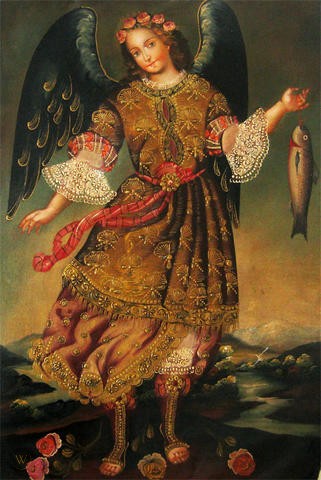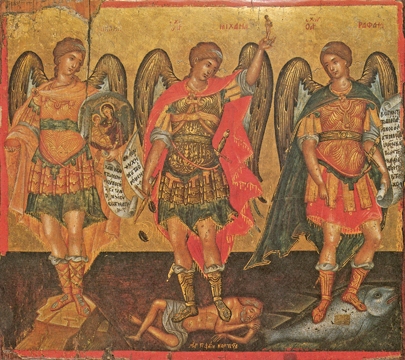
Archangel Raphael tells us in the Book of Tobit that he is one of the seven archangels that stand before the throne of God, offering the prayers of the saints like incense. We know the names of three other archangels: Michael, Gabriel, and Uriel. Michael is known as a warrior and Gabriel is a messenger while Uriel is a keeper of secrets but Raphael is known as a healer.
In Tobit, St. Raphael tells Tobias how to use the heart, liver, and gall of a large fish to save Sarah and heal his father’s eyes. Because of this, Raphael is often considered the patron of the blind and of pharmacists who mix or oversee the use of medicinal herbs and drugs for healing ailments. Because he also bound the demon Asmodeus in chains when Asmodeus fled to Egypt, the archangel is also the guardian of those possessed or under attack by the demons. Asmodeus attacked Sarah at night, so Raphael is invoked against nightmares.
In the Old Testament, the land of Egypt is both a symbol of fertility or safety and the “land of the shadow of Death,” the region most associated with all that is opposed to God. Egypt was the source of food that saved Joseph and his brothers and the people of Israel who came to escape the famine in the Promised Land. Egypt is the fertile bread basket of the Ancient World, including Greece and the Roman Empire. The importance of Egypt as food source continued into the Byzantine period. The known world relied on Egypt to survive for centuries. The prophets refer to Egypt as a garden similar to Eden (esp. Jeremiah and Isaiah), providing all that humans need to live. Yet Origen says that “Egypt” is the world steeped in Death because Pharaoh opposed God, inflicting suffering and death on the Chosen People; Pharaoh brought down the Ten Plagues, killing many of his own people as the water was undrinkable or the cattle sickened and died even before the firstborn were slain. Most of his soldiers drowned at the Red Sea. The gods worshipped in Egypt were thought to be devils in disguise by the Christians as well. The wilderness of the Egyptian desert was the home of devils and demons so mons and nuns went out into the wilderness to pray and fight against the devil on his own turf.
Asmodeus fled to Egypt because that was the natural home on earth of all demons. Raphael bound him in chains and imprisoned Asmodeus in Egypt because the desert of Egypt is the icon of Hell.
In Greek, the words “health” and “salvation” are slightly different versions of the same word. Miracles of healing are paradigms of salvation. Raphael brought health and salvation to Tobit, Tobias, and Sarah–the family that stands in for the human race. Because Raphael saved them, he guards and protects us all.
St. Raphael keeps an eye on New York as well. He stands atop the Bethesda Fountain in Central Park (designed by Emma Stebbins, who was the first woman to receive a public commission for a major work of art in New York City and completed in 1873) because the fountain refers to Healing the paralytic at Bethesda, a story from the Gospel of John (chapter 5) about an angel blessing the Pool of Bethesda, giving it healing powers. Folklore has always insisted that the angel who troubled the water at Bethesda was St. Raphael.

